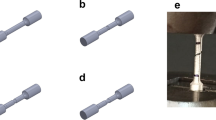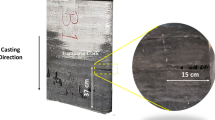Abstract
The effect of Sc addition to AA2195 (NoSc) alloy by 0.025 wt% (LoSc) and 0.25 wt% (HiSc) on the evolution of microstructure, texture and mechanical property in AA2195 alloy during room temperature HPT processing was studied by electron microscopy, X-ray diffraction and Vicker’s microhardness test, respectively. Higher amount of Sc addition increased the volume fraction of precipitates formed after HPT processing by 5 rotations, as inferred from both STEM-HAADF imaging and high-resolution X-rays diffraction pattern analysis. This was primarily attributed to the size, distribution and morphology of the precipitates. Increased Sc content resulted in the decrease in solid solubility of Cu in the Al matrix, thereby causing higher precipitation of Cu containing precipitates. The increase in Sc content resulted in decreased intensities of the \(A_{1}^{*}\) and \(A_{2}^{*}\) ideal shear texture components and an increase in the intensity of the C components ({100} < 011 >), resulting from the easier dynamic recovery and recrystallization that occurs with the presence of larger precipitates. As a result, the highest microhardness was achieved in the LoSc alloy due to the formation of a nanocrystalline microstructure along with a homogeneous distribution of nanoscaled precipitates. This fine distribution of precipitates in LoSc alloy retained the smallest crystallite size and highest dislocation density at the disk periphery around a strain of 30. These enhanced properties in LoSc were attributed to the nearly homogeneous formation of fine precipitates ranging between 15 and 25 nm within the grains and < 100 nm at the grain boundaries during HPT processing.












Similar content being viewed by others
References
Gault B, de Geuser F, Bourgeois L, Gabble BM, Ringer SP, Muddle BC (2011) Atom probe tomography and transmission electron microscopy characterisation of precipitation in an Al–Cu–Li–Mg–Ag alloy. Ultramicroscopy 111:683–689. https://doi.org/10.1016/j.ultramic.2010.12.004
Khushaim M, Boll T, Seibert J, Haider F, Al-Kassab T (2015) Characterization of precipitation in Al–Li alloy AA2195 by means of atom probe tomography and transmission electron microscopy. Adv Cond Matter Phys. https://doi.org/10.1155/2015/647468
Es-Said OS, Parrish CJ, Bradberry CA, Hassoun JY, Parish RA, Nash A, Smythe NC, Tran KN, Ruperto T, Lee EW, Mitchell D, Vinquist C (2011) Effect of stretch orientation and rolling orientation on the mechanical properties of 2195 Al–Cu–Li alloy. J Mater Eng Perform 20:1171–1179. https://doi.org/10.1007/s11665-010-9746-6
Hong-ying L, Jin-feng G, Zi-qiao Z, Chang-jian W, Yao S, Bin H (2006) Continuous cooling transformation curve of a novel Al–Cu–Li alloy. Trans Nonferrous Metals Soc China (Engl Ed) 16:1110–1115
Nayan N, Murty SVSN, Jha AK, Pant B, Sharma SC, George KM, Sastry GVS (2013) Processing and characterization of Al–Cu–Li alloy AA2195 undergoing scale up production through the vacuum induction melting technique. Mater Sci Eng, A 576:21–28. https://doi.org/10.1016/j.msea.2013.03.054
Kim JH, Jeun JH, Chun HJ, Lee YR, Yoo JT, Yoon JH, Lee HS (2016) Effect of precipitates on mechanical properties of AA2195. J Alloy Compd 669:187–198. https://doi.org/10.1016/j.jallcom.2016.01.229
Gayle FW, Heubaum FH, Pickens JR (1990) Structure and properties during aging of an ultra-high strength Al–Cu–Li–Ag–Mg alloy. Scr Metall Mater 24:79–84. https://doi.org/10.1016/0956-716X(90)90570-7
Hekmat-Ardakan A, Elgallad EM, Ajersch F, Chen XG (2012) Microstructural evolution and mechanical properties of as-cast and T6-treated AA2195 DC cast alloy. Mater Sci Eng, A 558:76–81. https://doi.org/10.1016/j.msea.2012.07.075
Nayan N, Narayana Murty SVS, Mukhopadhyay AK, Prasad KS, Jha AK, Pant B, Sharma SC, George KM (2013) Ambient and cryogenic tensile properties of AA2195T87 sheets with pre-aging cold work by a combination of cold rolling and stretching. Mater Sci Eng A 585:475–479. https://doi.org/10.1016/j.msea.2013.08.001
Garmestani H, Kalidindi SR, Williams L, Bacaltchuk CM, Fountain C, Lee EW, Es-Said OS (2002) Modeling the evolution of anisotropy in Al–Li alloys: application to Al–Li 2090–T8E41. Int J Plast 18:1373–1393. https://doi.org/10.1016/S0749-6419(01)00073-0
Kim NJ, Lee EW (1993) Effect of T1 precipitate on the anisotropy of AlLi alloy 2090. Acta Metall Mater 41:941–948. https://doi.org/10.1016/0956-7151(93)90028-Q
Suresh M, Sharma A, More AMM, Nayan N, Suwas S (2018) Effect of Scandium addition on evolution of microstructure, texture and mechanical properties of thermo-mechanically processed Al–Li alloy AA2195. J Alloy Compd 740:364–374. https://doi.org/10.1016/j.jallcom.2017.12.045
Royset J, Ryum N (2005) Scandium in aluminum alloys. Int Mater Rev 50:19–44. https://doi.org/10.1179/174328005X14311
Tolley A, Radmilovic V, Dahmen U (2005) Segregation in Al3(Sc, Zr) precipitates in Al–Sc–Zr alloys. Scripta Mater 52:621–625. https://doi.org/10.1016/j.scriptamat.2004.11.021
Mao Z, Chen W, Seidman DN, Wolverton C (2011) First-principles study of the nucleation and stability of ordered precipitates in ternary Al–Sc–Li alloys. Acta Mater 59:3012–3023. https://doi.org/10.1016/j.actamat.2011.01.041
Sauvage X, Duchaussoy A, Zaher G (2019) Strain induced segregations in severely deformed materials. Mater Trans 60:1151–1158. https://doi.org/10.2320/matertrans.MF201919
Mazilkin A, Straumal B, Kilmametov A, Straumal P, Baretzky B (2019) Phase transformations induced by severe plastic deformation. Mater Trans 60:1489–1499. https://doi.org/10.2320/matertrans.mf201938
Blank VD, Popov MY, Kulnitskiy BA (2019) The effect of severe plastic deformations on phase transitions and structure of solids. Mater Trans 60:1500–1505. https://doi.org/10.2320/matertrans.mf201942
Matsuda K, Yasumoto T, Bendo A, Tsuchiya T, Lee S, Nishimura K, Nunomura N, Marioara CD, Levik A, Holmestad R, Toda H, Yamaguchi M, Ikeda K, Homma T, Ikeno S (2019) Effect of copper addition on precipitation behavior near grain boundary in Al–Zn–Mg alloy. Mater Trans 60:1688–1696. https://doi.org/10.2320/matertrans.l-m2019828
Edalati K (2019) Metallurgical alchemy by ultra-severe plastic deformation via high-pressure torsion process. Mater Trans 60:1221–1229. https://doi.org/10.2320/matertrans.MF201914
Bachmaier A, Pippan R (2019) High-pressure torsion deformation induced phase transformations and formations: new material combinations and advanced properties. Mater Trans 60:1256–1269. https://doi.org/10.2320/matertrans.MF201930
Lee S, Horita Z, Hirosawa S, Matsuda K (2012) Age-hardening of an Al–Li–Cu–Mg alloy (2091) processed by high-pressure torsion. Mater Sci Eng, A 546:82–89. https://doi.org/10.1016/j.msea.2012.03.029
Nasedkina Y, Sauvage X, Bobruk EV, Murashkin MY, Valiev RZ, Enikeev NA (2017) Mechanisms of precipitation induced by large strains in the Al–Cu system. J Alloy Compd 710:736–747. https://doi.org/10.1016/j.jallcom.2017.03.312
Straumal BB, Mazilkin AA, Sauvage X, Valiev RZ, Straumal AB, Gusak AM (2015) Pseudopartial wetting of grain boundaries in severely deformed Al–Zn alloys. Russ J Non-Ferrous Metals 56:44–51. https://doi.org/10.3103/S1067821215010198
Straumal BB, Sauvage X, Baretzky B, Mazilkin AA, Valiev RZ (2014) Grain boundary films in Al-Zn alloys after high pressure torsion. Scr Mater 70:59–62. https://doi.org/10.1016/j.scriptamat.2013.09.019
Duchaussoy A, Sauvage X, Edalati K, Horita Z, Renou G, Deschamps A, De Geuser F (2019) Structure and mechanical behavior of ultrafine-grained aluminum-iron alloy stabilized by nanoscaled intermetallic particles. Acta Mater 167:89–102. https://doi.org/10.1016/j.actamat.2019.01.027
Hyde KB, Norman AF, Prangnell PB (2001) The effect of cooling rate on the morphology of primary Al3Sc intermetallic particles in Al–Sc alloys. Acta Mater 49:1327–1337. https://doi.org/10.1016/S1359-6454(01)00050-7
Zhu H, Dahle AK, Ghosh AK (2009) Effect of Sc and Zn additions on microstructure and hot formability of Al–Mg sheet alloys. Metall Mater Trans A: Phys Metall Mater Sci 40:598–608. https://doi.org/10.1007/s11661-008-9728-6
Yin Q, Chen G, Teng X, Huang Y (2022) Interaction of dislocation/compensated precipitates and mechanical property optimization of electron beam welded aluminum–lithium alloy with scandium addition. Mater Sci Eng, A 851:143662. https://doi.org/10.1016/j.msea.2022.143662
Yin Q, Chen G, Shu X, Zhang B, Li C, Dong Z, Cao J, An R, Huang Y (2023) Analysis of interaction between dislocation and interface of aluminum matrix/second phase from electronic behavior. J Mater Sci Technol 136:78–90. https://doi.org/10.1016/j.jmst.2022.07.020
Mondal S, Bansal U, Makineni SK (2022) On the fabrication of atom probe tomography specimens of Al alloys at room temperature using focused ion beam milling with liquid Ga ion source. Microsc Res Tech. https://doi.org/10.1002/jemt.24151
Ungár T, Gubicza J, Ribárik G, Borbély A (2001) Crystallite size distribution and dislocation structure determined by diffraction profile analysis: principles and practical application to cubic and hexagonal crystals. J Appl Crystallogr 34:298–310. https://doi.org/10.1107/S0021889801003715
Ungár T, Dragomir I, Révész Á, Borbély A (1999) The contrast factors of dislocations in cubic crystals: the dislocation model of strain anisotropy in practice. J Appl Crystallogr 32:992–1002. https://doi.org/10.1107/S0021889899009334
Tsuji N, Gholizadeh R, Ueji R, Kamikawa N, Zhao L, Tian Y, Bai Y, Shibata A (2019) Formation mechanism of ultrafine grained microstructures: various possibilities for fabricating bulk nanostructured metals and alloys. Mater Trans 60:1518–1532. https://doi.org/10.2320/matertrans.mf201936
Han J, Zhu Z, Li H, Gao C (2016) Microstructural evolution, mechanical property and thermal stability of Al–Li 2198–T8 alloy processed by high pressure torsion. Mater Sci Eng, A 651:435–441. https://doi.org/10.1016/j.msea.2015.10.112
Alhamidi A, Horita Z (2015) Grain refinement and high strain rate superplasticity in alumunium 2024 alloy processed by high-pressure torsion. Mater Sci Eng, A 622:139–145. https://doi.org/10.1016/j.msea.2014.11.009
Mohamed IF, Yonenaga Y, Lee S, Edalati K, Horita Z (2015) Age hardening and thermal stability of Al–Cu alloy processed by high-pressure torsion. Mater Sci Eng, A 627:111–118. https://doi.org/10.1016/j.msea.2014.12.117
Jiang L, Li JK, Cheng PM, Liu G, Wang RH, Chen BA, Zhang JY, Sun J, Yang MX, Yang G (2014) Experiment and modeling of ultrafast precipitation in an ultrafine-grained Al–Cu–Sc alloy. Mater Sci Eng, A 607:596–604. https://doi.org/10.1016/j.msea.2014.04.045
Hirosawa S, Hamaoka T, Horita Z, Lee S (2013) Methods for designing concurrently strengthened severely deformed age-hardenable aluminum alloys by ultrafine-grained and precipitation hardenings. Metall Mater Trans A. https://doi.org/10.1007/s11661-013-1730-y
Kawasaki M, Foissey J, Langdon TG (2013) Development of hardness homogeneity and superplastic behavior in an aluminum–copper eutectic alloy processed by high-pressure torsion. Mater Sci Eng, A 561:118–125. https://doi.org/10.1016/j.msea.2012.10.096
Shen YF, Guan RG, Zhao ZY, Misra RDK (2015) UFG Al-Sc-Zr alloy: The mechanistic contribution of nano-sized precipitates on grain refinement during the novel process of accumulative continuous extrusion. Acta Mater 100:247–255. https://doi.org/10.1016/j.actamat.2015.08.043
Poduri R, Chen LQ (1997) Computer simulation of the kinetics of order disorder and phase separation during precipitation of δ′ (Al3Li) in Al–Li alloys. Acta Mater 45:245–255. https://doi.org/10.1016/S1359-6454(96)00137-1
Xue C, Wang S, Zhang Y, Tian G, Yang X, Chang X, Ke Y, Xie Z, Wang J (2023) Uncovering the kinetics of Li-rich clusters and monodisperse core–shell Al3(Zr, Sc) structures in Al–Li–Cu alloys. Mater Sci Eng, A 881:145393. https://doi.org/10.1016/j.msea.2023.145393
Suwas S, Mondal S (2019) Texture evolution in severe plastic deformation processes. Mater Trans 60:1457–1471. https://doi.org/10.2320/matertrans.mf201933
Nadammal N, Kailas SV, Szpunar J, Suwas S (2015) Restoration mechanisms during the friction stir processing of aluminum alloys. Metall Mater Trans A: Phys Metall Mater Sci 46:2823–2828. https://doi.org/10.1007/s11661-015-2902-8
Naghdy S, Kestens L, Hertelé S, Verleysen P (2016) Evolution of microstructure and texture in commercial pure aluminum subjected to high pressure torsion processing. Mater Charact 120:285–294. https://doi.org/10.1016/j.matchar.2016.09.012
Azzeddine H, Bradai D, Baudin T, Langdon TG (2022) Texture evolution in high-pressure torsion processing. Prog Mater Sci 125:100886. https://doi.org/10.1016/j.pmatsci.2021.100886
Liu LH, Chen JH, Fan TW, Liu ZR, Zhang Y, Yuan DW (2015) The possibilities to lower the stacking fault energies of aluminum materials investigated by first-principles energy calculations. Comput Mater Sci 108:136–146. https://doi.org/10.1016/j.commatsci.2015.06.015
Zhilyaev AP, Langdon TG (2008) Using high-pressure torsion for metal processing: fundamentals and applications. Prog Mater Sci 53:893–979. https://doi.org/10.1016/j.pmatsci.2008.03.002
Chen Y, Gao N, Sha G, Ringer SP, Starink MJ (2015) Strengthening of an Al–Cu–Mg alloy processed by high-pressure torsion due to clusters, defects and defect-cluster complexes. Mater Sci Eng, A 627:10–20. https://doi.org/10.1016/j.msea.2014.12.107
Ungár T (2007) Characterization of nanocrystalline materials by X-ray line profile analysis. J Mater Sci 42:1584–1593. https://doi.org/10.1007/s10853-006-0696-1
Ungar T, Illy J, Kovacs I (1986) Dislocation structure and work hardening in polycrystalline Ofhc copper rods 34:1257–1267
Author information
Authors and Affiliations
Corresponding author
Additional information
Handling Editor: Megumi Kawasaki.
Publisher's Note
Springer Nature remains neutral with regard to jurisdictional claims in published maps and institutional affiliations.
Rights and permissions
Springer Nature or its licensor (e.g. a society or other partner) holds exclusive rights to this article under a publishing agreement with the author(s) or other rightsholder(s); author self-archiving of the accepted manuscript version of this article is solely governed by the terms of such publishing agreement and applicable law.
About this article
Cite this article
Mondal, S., Raghavendra, K.G., Panigrahi, A. et al. Effect of Sc addition on evolution of microstructure, texture and strength of high-pressure torsion-processed AA2195 Al–Li alloy. J Mater Sci 59, 5717–5735 (2024). https://doi.org/10.1007/s10853-024-09569-6
Received:
Accepted:
Published:
Issue Date:
DOI: https://doi.org/10.1007/s10853-024-09569-6




